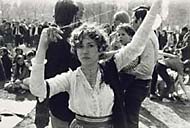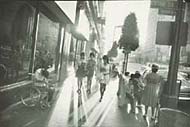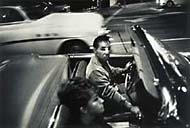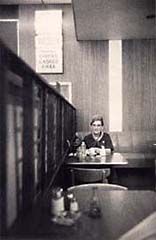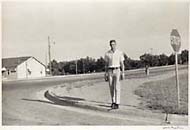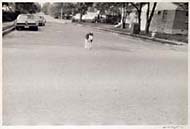|
On Easter Sunday 1967, the Sheep Meadow in Central Park was the scene of New York's first "be-in." Modeled on an earlier San Francisco event with the full name "A Gathering of the Tribes for a Human Be-In" that was presided over by hallucinogen guru Timothy Leary and beat poet Allen Ginsberg, the New York version of this open-air festival reportedly attracted 10,000 people. Out of the crowd, Winogrand chose this young woman in handmade clothing and jewelry to represent the celebration of cultural revolution going on around her.
|
 |
|
Winogrand constantly pushed the limits of what is considered a good picture. He used a wide-angle lens to crowd his composition with as much activity, detail, and information about the human condition as the picture frame could hold. He shot against the light, here challenging the California sun to ruin his representation of three women strolling down Hollywood Boulevard. With their slim figures, short dresses, and belabored coiffures, they are the essence of this picture, but other characters in this afternoon drama on Hollywood's Walk of Fame include the disabled young man in a wheelchair at left and the boy waiting with his mother at a bus stop at right.
|
 |
|
This image reflects the kind of miraculous events that his incredulous colleagues claimed happened only when Winogrand was around. According to the photographer, the couple, sitting in a parked convertible in front of a nightclub on Sunset Boulevard, continued their conversation (or argument?) while the photographer shot them from the sidewalk.
|
 |
|
In addition to Walker Evans, the Realist painter Edward Hopper is part of the tradition that produced William Eggleston's distinctively American, late-20th-century style. In the first half of the century, Hopper mastered the theme of the lone city dweller, usually situated in an interior setting. Eggleston's isolated customer having coffee in a bus station café or some equally plain, plastic environment could be compared to Hopper's canvas titled Automat.
|
 |
|
The entry about Eggleston in The Encyclopedia of Southern Culture suggests that his rural Mississippi childhood experience enabled him to communicate the "urban-industrial spirit" that has invaded that environment and to describe the "abrupt boundaries between city pavements and country roads, suburban houses and rolling fields." His photographs are, simply put, "about country people living in the city." This awkwardly tall man, perhaps a young recruit in basic training, appears to be one of those people. His height, relative to everything around him, defies probabilities.
|
 |
|
Dogs populate many of Eggleston's photographs. They often appear lost, without master or purpose, of the "lone wolf" variety, as one of Eggleston's friends once commented. In his 1994 book, Horses and Dogs, the photographer stated that he liked the fact that dogs "seem to be everywhere," but he had not deliberately made a series of images about them. Instead, he said, "I approach a picture of a dog exactly the same way I do any other picture. The compositions are free. I've never known why there are so . . . many pictures of people. People in general are not that attractive." And, he added, "You don't see very many ugly dogs. Horses either."
|
 |
|
Diane Arbus images are unavailable because the Arbus Estate does not grant digital and electronic rights.
|
 |
